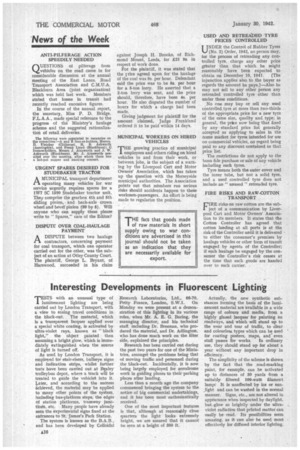Interesting Developments in Fluorescent Lighting
Page 18

If you've noticed an error in this article please click here to report it so we can fix it.
TESTS with an unusual type of 1 luminescent lighting are being carried out by London Transport, with a view to easing travel conditions in the black-out, The material, which is a transparent lacquer applied over a special white coating, is activated by ultra-violet rays, known as " black light," the object painted then assuming a bright glow, which is immediately extinguished when the source of light is turned off.
As used by London Transport, it is employed for stair-risers, buffseye signs and indication strips, whilst further tests have been carried out at 135xley trolleybus depot, where a track will be treated to guide the vehiclet into it. Later, and according to the success achieved, the material may be applied to many other points of the system, including bus-platform steps, the edges of station platforms, tramway junctionS, etc. Many people have already seen the experimental signs fixed at the entrances to St. James's Park Station.
The system is known as the B.A.B„ and has been developed by Colloidal Research Laboratories, Ltd., 66-70, Petty France, London, S.W.I. On Monday we were present at a demonstration of this fighting in its various roles, when Mr. A. E. G. Baring, the managing director, and his technical staff, including Dr. Brennan, who produced the material, and Dr. Adlington, who has done much work on the filter side, explained the principles.
Research has been carried out during the past two years for one of the Ministries, amongst the problems being that of moving traffic and personnel during the black-out. Incidentally, it is now being largely employed for aerodrome work in guiding planes to their parking places after landing.
Lees than a month ago the company commenced bringing the system to the notice of big commercial undertakings, and it has been most enthusiastically received.
One of the most important features is that, although at reasonably close quarters the light looks extremely bright, we are assured that it cannot be seen at a height of 300 ft. Actually, the new synthetic substances forming the basis of the
luminescent material are available in a wide range of colours and media, from a highly glazed lacquer for painting on roadways, and, which will stand up to the wear and tear of traffic, to clear and colourless types which can be used for coating posters, maps, and even
staff passes for works. In ordinary use, they should stand up for about a year without any important drop in efficiency.
The simplicity of the scheme is shown by the fact that the road-marking paint, for example, can be activated up to distances of 30 yards from a suitably filtered 100-watt filament lamp. It is unaffected by ice or sunlight and can be washed in the normal manner. Signs, etc., are not altered in appearance when inspected by daylight, but glow so brightly under the ultraviolet radiation that printed matter can easily be read. Its possibilities seem amazing, as it can also be used most effectively for diffused interior lighting.




















































